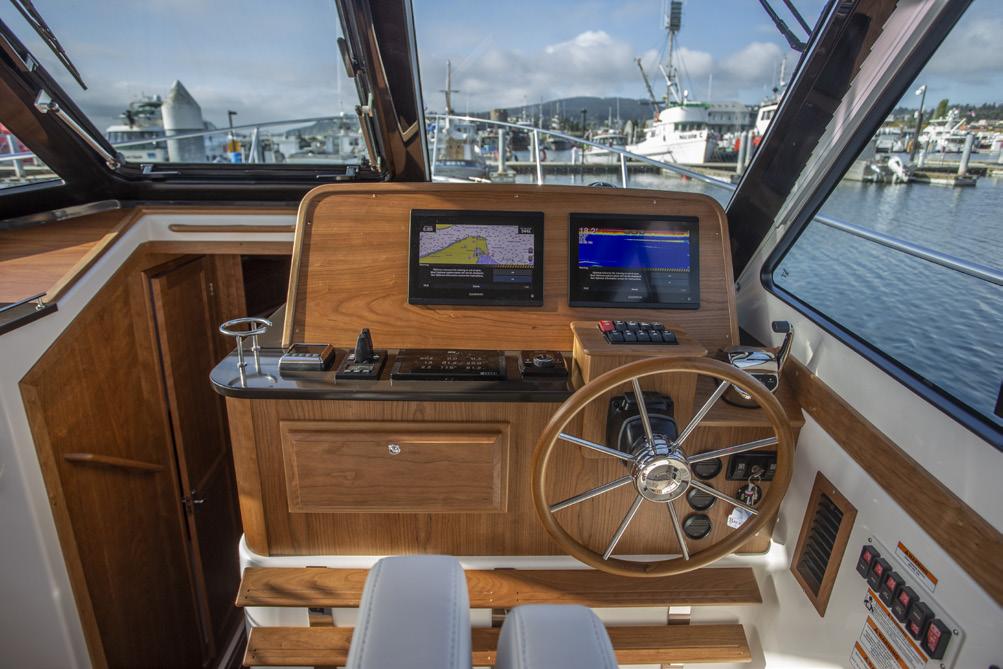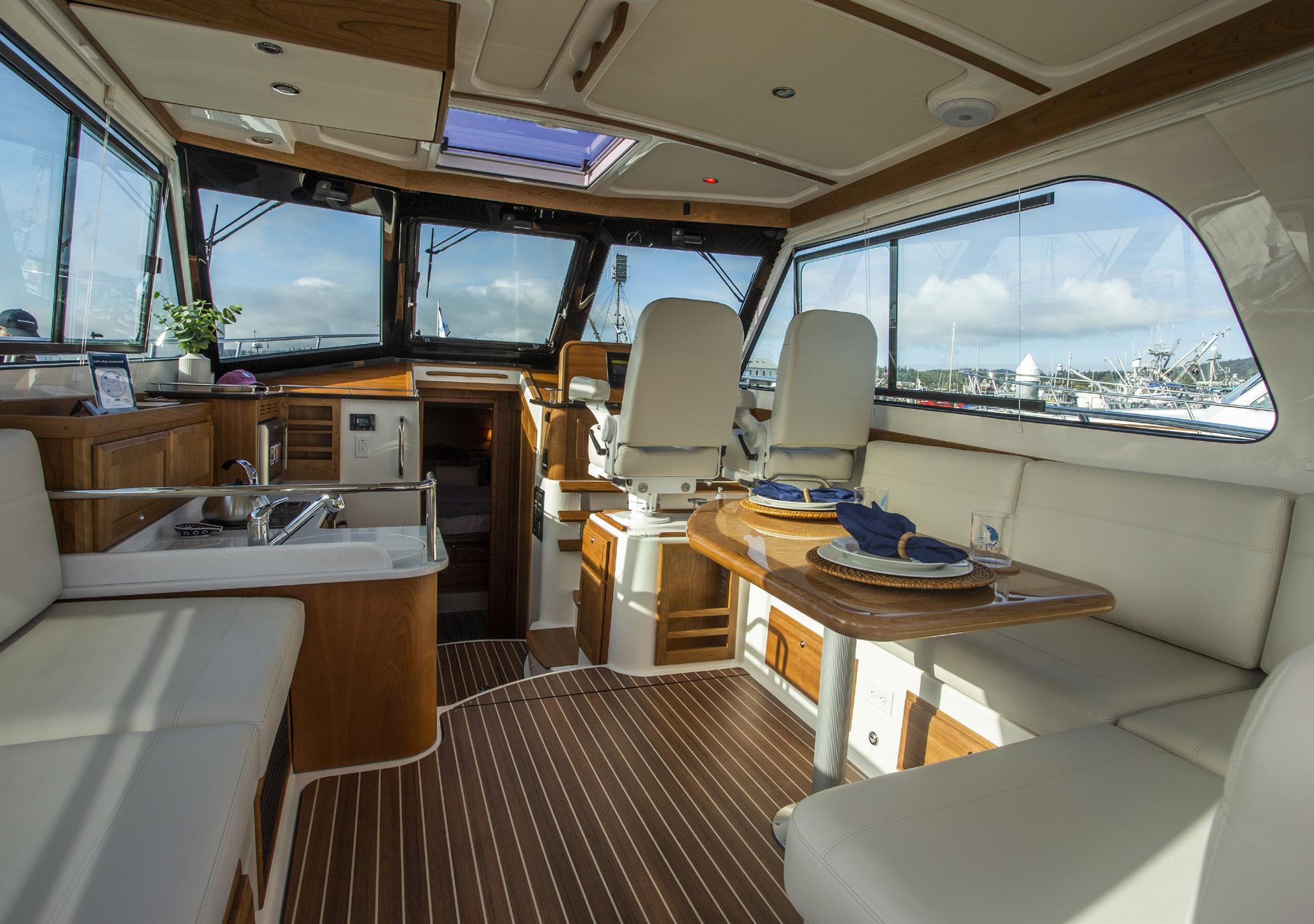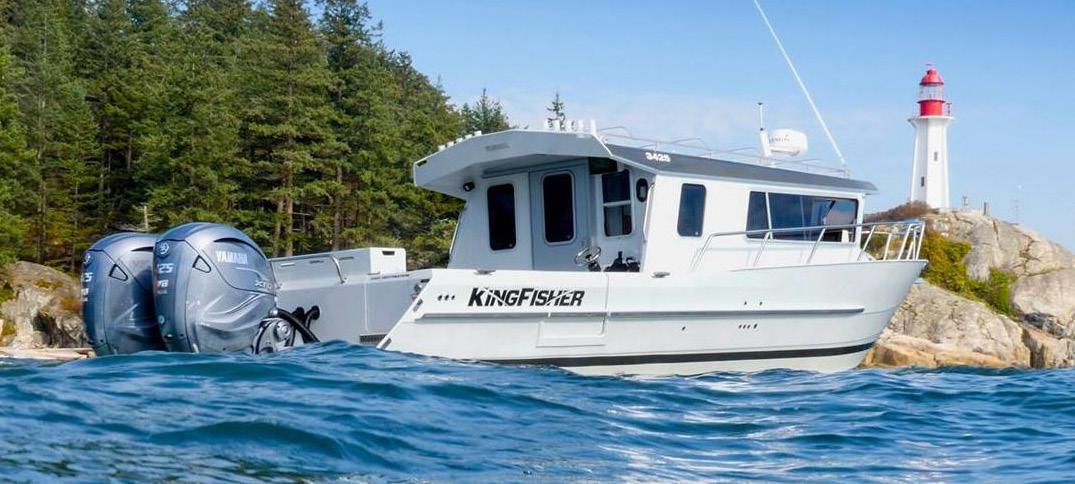
9 minute read
for Halibut
Ibut fisheries. This commission sets annual total allowable catches, while each country determines how their share of the catch will be allocated to domestic fishing groups. In Canada the catch is shared by First Nations, commercial and recreational fisheries with some dedicated for research. All harvest groups are part of the Canadian delegation at Halibut Commission meetings.
Pacific halibut have unusual characteristics. They begin life swimming normally with one eye on each side of their heads. However, within their first year they change into side-swimmers with one eye migrating to the same side as the other, like their smaller cousin the flounder. Halibut also grow to a massive size with females reaching more than 200 kilograms, while the males rarely exceed 30 kilograms. Halibut are migratory sometimes trav- elling many thousands of kilometres. The migration pattern is generally from offshore to the landward side of the continental shelf. Halibut are more plentiful, and larger, the further north they reside along the West Coast. A 13-kilogram California halibut would be classed as large, while in northern BC waters it would be an appreciated but unremarkable catch.
Advertisement
Halibut populations are healthy while some important salmon runs are not, resulting in unprecedented salmon restrictions. These conditions inevitably encourage anglers to shift fishing effort from salmon to halibut. Another motivation is their excellent quality as a table fish. When properly prepared, halibut is amongst the finest tasting seafood available.
The good news is halibut angling is fairly easy to learn. The bad news is it might require new investments in heavier rods, level wind reels and different terminal tackle to do it properly.

HALIBUT TACTICS & GEAR
Tactics
Lots of halibut are caught by anglers trolling or jigging for salmon, but these catches are accidental and inconsistent.
Salmon anglers who encounter halibut do so because they are:
• Fishing close to a mixed sand, gravel and cobble bottom.
• Jigging or trolling slowly during low current velocities.
• Using baits or lures that attract halibut.
In other words, they were unintentionally using the where, when and what to use basics of halibut fishing.
Where: Halibut like bottom structure with cobble, gravel and sand. So relatively flat underwater banks, shoals and gradually sloping beaches are perfect for these bottom feeders. They are less likely to be found hugging steep sloped drop-offs or muddy bottoms.
When: During slack water, halibut move from deep water onto shallower flats to feed on herring, crustaceans and other small fishes. Plan your fishing trips around the slacks when current velocity is less than two knots and lasts for long periods of time. Once you’ve committed to fish for halibut don’t lose patience if the bite isn’t immediate.
What to Use & How: There is a misconception that halibut are scavengers. While they do scavenge opportunistically, they are predators just like other apex saltwater species. Anglers need to keep this in mind and only use the best quality real baits or artificial lures with visual or scent cues that attract their attention. Halibut guides have adopted a sophisticated anchoring system that requires considerable investment in ground tackle. I doubt that weekend anglers or recreational boaters who just want an occasional halibut need to go to that extent unless they are determined to become halibut angling experts.
Optional ‘How-to’ Tactics
• Use your existing anchor system. This keeps the boat over your preferred fishing location. Be aware, however, it puts the anchor line close to the boat which risks entanglement when a halibut is on the line. Also, anchor far enough away from other boats so that wind and tide cannot push you onto their gear.
• Drift with the current. This is effective for jigging or using a spreader bar with herring or other natural baits. However, it does require constant rod tip monitoring to avoid bottom hook-ups. Anglers also must avoid drifting over anchor lines or fishing tackle from nearby anchored boats.
• Slow troll with downriggers. Keep your riggers within a few feet of bottom or even bounce bottom depending on the seabed composition. Run a 10 to 15-foot line from the rigger cable release clip to your bait or lure. Good baits include large scented hoochies, octopus tentacles, salmon belly and cod skin strips, or whole herring trolled in a teaser head or cutplugged.
Even small halibut can destroy salmon rods. Consequently, anglers need stiff six to seven-foot rods and star drag reels. Your line choice is also important. Purchase non-stretch fishing line and add a

TOM'S TIP
March’s Fishing Tip
There aren’t many slow current halibut tides each month. So, find out when they are and fish them. These provide the best chance to put halibut on your dinner table.
few feet of 80 to 100-pound test leader between your baits and the main line. Landing a strong halibut is hard work. Electric reels make it easier. However, they cost from $700 to $2,400 should you have the urge to upgrade.
Fortunately, buying terminal tackle takes a much smaller bite out of your wallet. If you choose to slow troll with your downriggers, purchase some bigger hoochies. Or try eight to 10-inchlong salmon belly strips, similar sized octopus tentacles or herring rigged with big single hooks.
Jigging for halibut is another inexpensive option. Purchase a few halibut jigs with glow hoochies already attached; or just buy some jigs and tip them with real bait.
Spreader bars fished from an anchored boat are common halibut fishing gear. The bar has three connection points. One is for the main fishing line, the second takes the leader and bait and the third suspends a weight to keep the bait a few feet above bottom.



A hoochie tipped with real bait works well when fishing for halibut.

We make getting out of boat ownership a breeze. Donate your boat in support of our local community of sailors with disabilities and receive a tax receipt for its full market value.




We call that a win-win.
We call that a win-win.
more at www.asabc.org/breeze
FOLLOW
THE RULES
Back Cove 372
BY ARNIE HAMMERMAN
TThe Back Cove 372, sporting a navy-blue hull and simple lobsterboat-inspired lines, presents a nice contrast to the chunky, modern styling of many new boats that seem to have abandoned any attempt to remain nautical. Perhaps it is the sailor in me, but I like boats that look like boats, and while I switched to power years ago, I don’t mind trading super-fast speeds for reasonable fuel burn. That is why the Back Cove 372 has so much appeal, it simply ticks a lot of boxes. The Back Cove cruises nicely at 20 knots using 60 litres per hour (15.8 gallons), has a smooth ride, comfortable cruising accommodations and timeless aesthetics that showcase deep maritime roots.
DESIGN AND CONSTRUCTION Boating experience has led me to respect practicality. Sometimes simple is better, and when a boat builder like Back Cove combines the pragmatism of a single diesel engine with the elegance of downeast styling it impresses me. That does not mean that the Back Cove 372 is old fashioned, far from it, as the boats are built with innovative composite technology and packed with modern amenities. The boats just aren’t frivolous. Back Coves and their sister brand Sabre Yachts are serious like their experienced Maine-based builders. Their time-honoured styling not only looks good, but the design has been proven to perform and to endure in all conditions.



Like the commercial boats they are loosely derived from, Back Coves are designed to handle the rugged conditions of coastal Maine. Hull bottoms are cored with PVC foam, vacuum infused and reinforced with a resin infused foam core stringer system. Resin infused balsa coring is used in the deck, which should not be off putting, because the way they isolate the wood should eliminate issues. End grain balsa is scored into a fabric backed grid and infusion encapsulates each cell with resin preventing water intrusion. Cleats, rails and fittings are attached through solid sections, so fasteners don’t penetrate the coring. Back Cove prefers to use balsa because it maintains its strength in the long stretches of deck creating thinner panels that reduce weight.
SYSTEMS The Back Cove 372 is powered by a single Cummins QSC8.3 600-horsepower diesel that provides efficiency and range (Volvo Penta D8 is an option). I found dockside manoeuvrability effortless using the Side-Power joystick-controlled standard bow and optional stern thruster on our test boat. The boat is set up to be easily handled by a couple and with two of us on board it was simple, with well-placed cleats, reasonable side decks, steps and stainless railings. An opening side window beside the helm eases communication while docking. Visibility is excellent from the helm and matching companion seat through three large windshields, the centre of which opens, all surrounded by blacked out mullions for glare reduction.




The aft bifold stainless and glass doors connect the saloon to the cockpit and provide good sightlines aft from the helm whether open or closed. Controls and electronics are accessed in a convenient dash pod from the Llebroc Ultraleather adjustable helm seat. An illuminated compass, USB charging station for phones, tablets and gadgets and a drawer for binoculars are nice touches. Three footrests provide comfortable positioning, and the 20-inch Stazo wood grain wheel can be adjusted.
ON TEST I throttle up and accelerate smoothly out of Anacortes and into Padilla Bay to an impressive wide-open speed of 28.6 knots. Then settle back to 2,500 RPM where a fast cruise of 23 knots uses 79.7 litres per hour (21.1 gallons) yielding a modest 1.1 miles per gallon. At this speed, the efficiency of the single diesel yields a range of 296 miles based on 90 percent of the 1,136-litre (300-gallon) capacity. This gives the Back Cove 372 both the speed and range for extended cruising of the islands and the Inside Passage. At trawler speeds, range increases to more than 1,000 miles, allowing the Back Cove to cruise to Alaska. The SeaStar hydraulic steering is lively and responsive, and the boat gently heels into turns. The Back Cove 372 feels comfortable and secure at the helm, and with a 10,024-kilogram (22,100-pound) displacement it tracks evenly and cuts through wakes without notice. The hull is a modified V forward with camber from the bow to the transom, creating a curved surface that softens the ride. The prop is in a tunnel and partially protected by a keel, skeg and rudder, creating a reasonable three-foot, seveninch (1.09-metre) draft that allows for shallow-water cruising.
INTERIOR The Back Cove 372 has a comfortable, fully climate-controlled saloon lounge area with a fold down table aft of the helm. A 32-inch LED Smart TV flips from the ceiling and pivots for better viewing from the saloon seating. When the weather is warm bifold doors fully open, joining the saloon to the cockpit, where plentiful seating both inside and out is ideal for simply relaxing or when entertaining. The fully equipped galley is a few steps down from the saloon under the light of the windshield and features refrigerator/freezer drawers, an electric two-burner Kenyon induction cooktop and a deep stainless-steel sink with cover. A cut out in the Corian countertop cleverly pulls out so you can wipe debris directly into the garbage below. This mid galley provides convenient access to the helm and the seating and gathering areas aft. Windows and hatches with screens keep the saloon and galley light and airy and provide pleasant cross breezes when opened.
The master cabin forward has a queen island berth with reading lights, an overhead hatch, a cedar lined hanging locker and plenty of drawers and storage. A handy en suite door provides access to the head, which has a Tecma electric freshwater toilet and a separate shower compartment with a molded-in bench. The second private cabin is great for children and single adults. The limiting factor is the bed which is 91.4 centimetres (three feet, 10 inches) wide. The saloon table also converts to create a larger bed that can accommodate a second couple. The interior of the Back
Cove is brightly decorated with American cherry, which when combined with fine upholstery and quality fixtures creates a lively, nautical feel. “Teak and holly” soles add to the ambiance but are made of more practical textured highpressure laminate.
IF YOU ARE TIRED of new boats that look like shoe boxes and have more windows in their hulls than above deck, this stylish and practical cruiser should appeal to you. The Back Cove 372 can be easily handled by a couple and has the fuel economy, range and durability to cruise anywhere in style and comfort. Finely crafted and ruggedly constructed in North America this cruiser looks like a boat, handles like a boat and delivers a lot in a compact timeless design.
SPECS
LOA: 12.80 m / 42' 8"
Hull Length: 11.64 m / 38' 2"
Beam: 4.04 m / 13' 3"
Draft: 1.09 m / 3' 7"
Bridge clearance: 3.81 m / 12' 6"
Displ.: 10,024 kg / 22,100 lbs
Fuel (Diesel): 1,136 L / 300 USG
Freshwater: 454 L / 120 USG
Holding Tank: 189 L / 50 USG
Generator: Onan 9KW
Standard Power: 1X Cummins
QSC8.3 600HP (shaft drive)
Optional Power: 1X Volvo Penta D-8 600HP (shaft drive)
Built by: Back Cove Yachts, Maine backcoveyachts.com
Sold by: Bellingham Yachts, Bellingham WA 360-671-0990 bellinghamyachts.com



































































